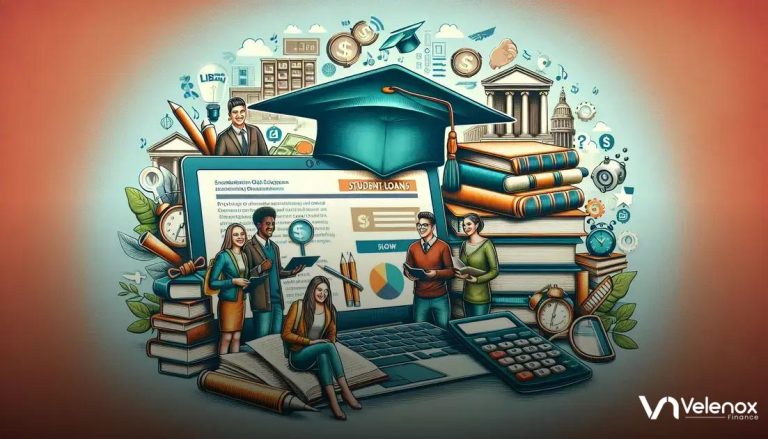Student loans can be a lifesaver for those pursuing higher education, but understanding how to navigate the options is crucial.
Understanding different types of student loans
When it comes to student loans, it’s crucial to understand the different types available to you. Federal student loans are offered by the government and generally have lower interest rates compared to private loans. They include Direct Subsidized Loans and Direct Unsubsidized Loans. Subsidized loans are need-based, and the government pays your interest while you’re in school. Unsubsidized loans aren’t need-based and you are responsible for all the interest accrued.
Another option is the Direct PLUS Loans, which are available to graduate students and parents of dependent undergraduates. These loans require a credit check and may have higher interest rates.
Private student loans are provided by banks and other non-government institutions. They can help bridge the gap if federal loans and scholarships don’t cover all your expenses. However, they usually come with higher interest rates and less flexible repayment options.
ADVERTISEMENT
Understanding these different types of loans can help you make the best decision for your financial future. Be sure to consider interest rates, repayment options, and eligibility criteria to identify which loans best suit your needs.
How to Apply for student loans

Research Loan Options
Before applying for student loans, thoroughly research all available options. This includes federal loans, such as Direct Subsidized Loans and Direct Unsubsidized Loans, and private loans from banks or other financial institutions.
Complete the FAFSA
The first step in applying for federal student loans is filling out the Free Application for Federal Student Aid (FAFSA). This form is essential for determining your eligibility for federal aid, including grants, work-study programs, and loans. Make sure to complete it accurately and submit it before the deadline.
Understand Loan Terms
It’s crucial to understand the terms of any loan you consider. Pay attention to the interest rates, repayment schedules, and any fees associated with the loan. Federal loans typically offer better terms and more flexibility compared to private loans.
Use a Loan Comparison Tool
There are many online tools available to help you compare different student loan options. These tools can provide comprehensive comparisons of interest rates, repayment periods, and borrower benefits, helping you make an informed decision.
Submit Your Application
Once you’ve chosen the best loan options, submit your applications. For federal loans, this will involve a process through the U.S. Department of Education. For private loans, you will need to apply directly through the lender’s website.
Wait for Approval
After submitting your application, you will need to wait for approval. Federal loan approvals can take several weeks, while private loans might provide faster responses. Be patient and keep track of your application status.
Review Your Loan Offer
If your loan application is approved, you will receive a loan offer. Review the offer carefully to ensure it meets your needs. If you have questions, don’t hesitate to contact the lender or your school’s financial aid office for clarification.
Managing your student loan debt
Effectively managing your student loan debt is crucial for financial stability after graduation. Start by creating a detailed budget that accounts for all income and expenses. This helps you understand how much you can allocate towards loan payments each month. Utilize income-driven repayment plans if your monthly payments are too high, as these adjust according to your income.
Consider setting up automatic payments to ensure you never miss a due date. Many lenders offer rate reductions for automatic payments, which can save you money in the long run. If you have multiple loans, explore consolidation options to simplify your payments. However, always weigh the pros and cons, such as potentially losing borrower benefits.
Keep track of your loans and their terms. Use online tools and apps to monitor your balances, payment history, and interest rates. Communicate with your loan servicer regularly to stay informed about any changes or opportunities for deferment or forbearance if you’re facing financial hardship.
Explore Loan Forgiveness Programs
Programs such as Public Service Loan Forgiveness (PSLF) can eliminate remaining balances after several years of qualifying payments. Research and understand the eligibility criteria and required steps to benefit from these programs.
Tips for paying off student loans faster

If you want to pay off your student loans faster, there are several strategies you can employ to speed up the process. First, consider making extra payments whenever possible. Even small additional payments can significantly reduce the principal balance over time.
Another effective tactic is to refinance your student loans. By obtaining a lower interest rate, you can save money and pay off your loans more quickly. Look for lenders that offer competitive rates and terms suitable to your financial situation.
It’s also important to create a budget and identify areas where you can save money. Redirecting savings from daily expenses towards your student loan payments can make a big difference. Additionally, using windfalls such as tax refunds, bonuses, or gifts to make lump-sum payments can accelerate your payoff timeline.
Setting up automatic payments can help you stay on track and avoid late fees, which can be detrimental to your financial health. Some lenders even offer interest rate reductions for enrolling in auto-pay, adding to your savings.
If you have multiple loans, consider using a debt snowball or debt avalanche method. With the debt snowball method, you pay off the smallest loan first while making minimum payments on others; with the debt avalanche, you target the loan with the highest interest rate.
Alternatives to traditional student loans
Scholarships and Grants: Unlike traditional student loans, scholarships and grants provide financial aid that does not need to be repaid. These funds can be awarded based on merit, need, or specific talents and are offered by various institutions, including universities, private organizations, and government bodies. Applying for scholarships and grants can significantly reduce the financial burden of education.
Work-Study Programs: Many colleges offer work-study programs that allow students to work part-time while attending classes. These programs provide valuable work experience and help cover educational expenses. Payments from work-study jobs can go directly to tuition or be used for other college-related costs.
Income Share Agreements (ISA): ISAs are a modern alternative to traditional loans where students receive funding for their education in exchange for a percentage of their income after graduation. Repayment is based on what the student earns, making it a flexible option. This method also aligns the interests of the educational institutions and students towards successful career outcomes.
Personal Savings and Family Contributions: Utilizing personal savings or contributions from family members can help minimize the need for loans. It’s advisable to start saving early and explore educational savings plans like 529 plans, which offer tax benefits.
Employer Tuition Assistance: Some employers offer tuition assistance programs as part of their benefits package. This can include partial or full reimbursement for courses related to your current job or future career ambitions. Checking with your employer about these opportunities can provide significant financial relief.
Military and National Service: Enlisting in military service or national service programs like AmeriCorps can offer educational benefits. These programs may provide funding for tuition in exchange for service commitments, making education more affordable while serving the country.





